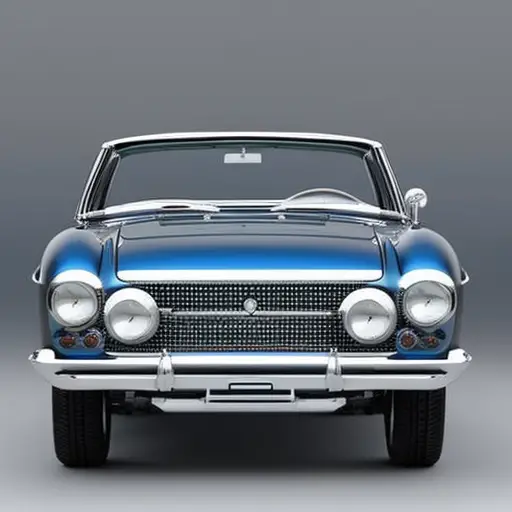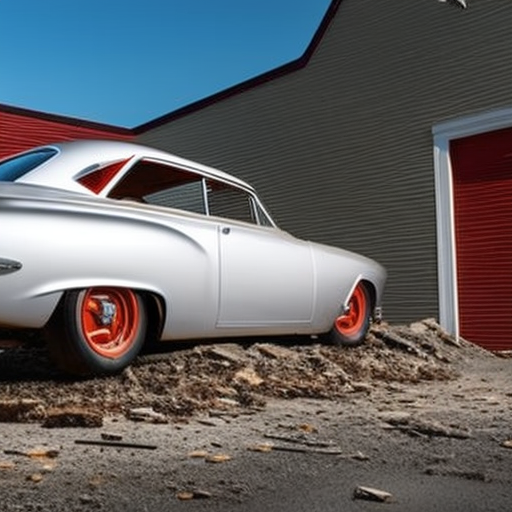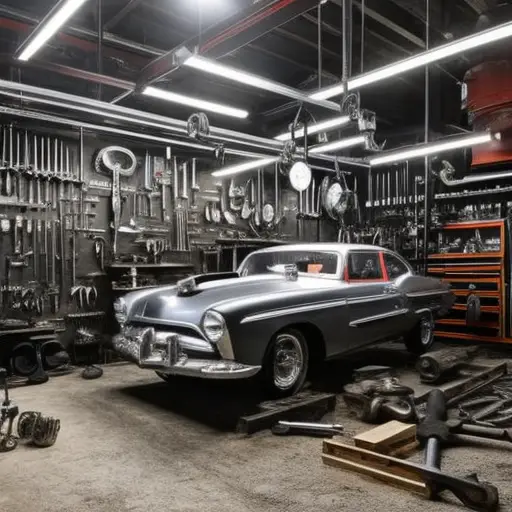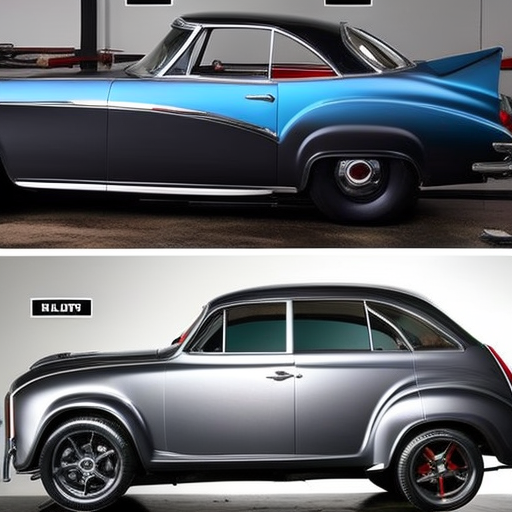The Legal Aspects of Restoring Classic Cars

Imagine the thrill of reviving a vintage classic car to its former glory, but amidst the exhilaration lies a labyrinth of legal considerations. From navigating environmental regulations to understanding intellectual property laws, restoring a classic car requires a comprehensive understanding of legal intricacies.
This article delves into the multifaceted legal aspects of restoring classic cars, providing invaluable insight for enthusiasts, collectors, and professionals in the automotive industry.
Obtaining the Necessary Permits
Acquiring the requisite permits is an essential step in ensuring legal compliance during the restoration of classic cars. The permit application process for classic car restoration typically involves several key steps.
First, it is essential to research and identify the specific permits required for the restoration project, as these may vary based on the location and scope of the work. Once identified, the next step is to complete the permit application forms accurately and submit them to the relevant regulatory authorities. This process often involves providing detailed information about the restoration project, including the types of work to be conducted, the materials to be used, and any environmental impact assessments if necessary.
After the submission of the permit application, it undergoes a regulatory approval process. During this stage, the authorities review the application to ensure that it complies with all relevant laws and regulations. This may involve inspections of the restoration site and assessments of the potential impact on the surrounding environment.
Once the regulatory approval process is complete, and the permits are granted, the restoration project can proceed in full compliance with the legal requirements, providing assurance to both the restorer and the community.
Understanding Environmental Regulations
When restoring classic cars, it is crucial to understand the environmental impact of the restoration process and ensure compliance with local environmental regulations.
This includes managing waste disposal, handling hazardous materials, and minimizing air and water pollution.
Environmental Impact of Restoration
Understanding environmental regulations is crucial for assessing the environmental impact of restoring classic cars. Waste disposal and carbon footprint are key considerations.
Proper disposal of hazardous waste such as old engine oils, batteries, and paints is essential to minimize environmental impact. Similarly, the carbon footprint of restoration activities, including the energy consumption during the restoration process and the sourcing of replacement parts, must be evaluated.
Compliance with regulations on waste disposal and emissions is vital to mitigate the environmental impact of classic car restoration.
In the next section, we will delve into the significance of compliance with local laws to ensure that the restoration process aligns with environmental regulations and legal standards.
Compliance With Local Laws
How can restoration activities for classic cars align with environmental regulations and legal standards regarding waste disposal and emissions?
Compliance with local laws is crucial in ensuring restoration activities for classic cars adhere to environmental regulations. Understanding local zoning ordinances is essential to ensure that restoration activities are conducted in areas where they are legally permitted. Restoration restrictions, such as limitations on the use of certain chemicals or materials, must be strictly adhered to. Additionally, compliance with emissions standards and waste disposal regulations is paramount. Proper disposal of hazardous materials and recycling of eligible components should be carried out in line with local laws. By acknowledging and adhering to these regulations, classic car restoration enthusiasts can contribute to environmental preservation and ensure legal compliance.
Furthermore, it is equally important to consider compliance with health and safety standards in the restoration process.
Compliance With Health and Safety Standards
As classic car restoration involves various safety considerations, it’s essential to ensure compliance with health and safety standards.
This includes understanding safety equipment requirements, handling hazardous materials, and protecting worker health.
Safety Equipment Requirements
The restoration of classic cars requires compliance with specific safety equipment standards dictated by health and safety regulations. Safety equipment requirements are integral to the restoration process, ensuring the protection of individuals involved in the restoration, as well as the future occupants of the classic car. These standards encompass a range of safety elements, including but not limited to, personal protective equipment for workers, fire safety measures, ventilation systems for the handling of hazardous materials, and the installation of safety features within the vehicle itself.
Adhering to these safety equipment standards not only ensures the well-being of those involved but also guarantees that the restored classic car meets modern safety requirements. Transitioning into the subsequent section about ‘handling hazardous materials’, it is crucial to understand the specific safety protocols and equipment necessary for this aspect of the restoration process.
Handling Hazardous Materials
During the restoration process, compliance with health and safety standards is imperative for handling hazardous materials. Proper waste disposal procedures must be followed to ensure the safe management of contaminated materials.
Classic car restoration often involves dealing with substances such as lead-based paints, asbestos, and other hazardous materials that can pose risks to both the environment and human health if not managed correctly. It is essential to adhere to regulations regarding the containment, transportation, and disposal of these materials to prevent environmental contamination and health hazards.
By implementing strict waste disposal protocols and utilizing appropriate personal protective equipment, classic car restoration businesses can ensure the safe handling and disposal of hazardous materials, thereby mitigating potential legal and environmental liabilities.
Transitioning into the subsequent section about ‘worker health protection,’ it is also crucial to prioritize measures that safeguard the well-being of individuals involved in the restoration process.
Worker Health Protection
Compliance with health and safety standards for worker health protection is paramount in the restoration of classic cars, particularly in managing hazardous materials and safeguarding the well-being of individuals involved in the restoration process.
To ensure worker health and safety during classic car restoration, the following measures must be adhered to:
-
Worker Training: All individuals involved in the restoration process must receive comprehensive training on the proper handling of hazardous materials and the correct usage of safety equipment.
-
Ventilation Requirements: Adequate ventilation systems must be in place to minimize the inhalation of harmful fumes and particles during the restoration activities.
-
Protective Gear: Workers should be provided with and required to wear appropriate personal protective equipment, including gloves, masks, and goggles.
-
Regular Safety Inspections: Periodic checks and maintenance of safety equipment and ventilation systems are essential to ensure their effectiveness.
-
Emergency Preparedness: Clear protocols for responding to accidents or exposure incidents must be established and communicated to all workers.
Navigating Intellectual Property Laws
Restoring classic cars involves navigating intellectual property laws to ensure compliance with copyright and trademark regulations.
Copyright protection is a crucial consideration when restoring classic cars, as it pertains to the reproduction of original automotive designs and logos. It is essential to obtain permission or ensure that the copyright for any design or logo used in the restoration process has expired. Failure to do so could result in copyright infringement, leading to legal consequences.
Additionally, trademark infringement is a significant concern when restoring classic cars, particularly when using logos or brand names associated with the original manufacturer. It is important to respect trademark rights and obtain proper authorization for the use of any trademarks during the restoration process. This may involve obtaining a license from the trademark holder or ensuring that the trademarks have expired.
Insurance and Liability Considerations
Navigating insurance and liability considerations is an essential aspect of classic car restoration, requiring meticulous attention to detail and a thorough understanding of potential risks. When restoring a classic car, it’s crucial to consider the following insurance and liability factors:
- Coverage requirements: Classic car insurance often has specific coverage requirements, such as agreed value coverage to ensure the full value of the vehicle in the event of a total loss.
- Liability limitations: Understanding the limitations of liability coverage is important, especially in cases where restoration may increase the value of the vehicle beyond standard coverage limits.
- Insurance claims: Familiarizing oneself with the claims process for classic car insurance is vital to ensure a smooth experience in the event of damage or loss.
- Accident responsibility: Knowing the extent of responsibility in the event of an accident involving the classic car is essential to avoid potential legal and financial consequences.
- Restoration impact: Understanding how restoration modifications can affect insurance coverage and potential liability in the event of an accident.
Considering these factors is crucial to protect both the investment in the classic car and the owner’s financial security. As classic car restoration often involves numerous legal aspects, understanding insurance and liability considerations is just the beginning.
Now, let’s delve into the complexities of import and export regulations.
Import and Export Regulations
Understanding import and export regulations is crucial for classic car restoration enthusiasts seeking to safeguard their investment and ensure compliance with international trade laws. When importing or exporting classic cars, it is essential to be aware of customs requirements and international trade regulations. These regulations can vary significantly from country to country and failure to comply can result in delays, fines, or even seizure of the vehicle.
Importing classic cars often involves paying import duties and taxes, and meeting specific safety and emissions standards. Some countries may also have restrictions on the import of certain classic cars, particularly those with historical or cultural significance.
On the other hand, when exporting classic cars, enthusiasts must ensure compliance with the export regulations of both the country of origin and the destination country. This may include obtaining export licenses, providing documentation of the vehicle’s provenance, and adhering to specific packaging and shipping requirements.
Navigating import and export regulations can be complex, but it is essential for classic car restoration enthusiasts to thoroughly research and understand the customs requirements and international trade regulations of the countries involved to ensure a smooth and compliant restoration process.
Resale and Auction Legalities
Adhering to resale and auction legalities is crucial for classic car restoration enthusiasts seeking to ensure compliance with relevant laws and regulations, especially when transferring ownership across international borders.
When navigating the resale and auction process for classic cars, it is important to consider the following key factors:
-
Auction Regulations: Familiarize yourself with the specific regulations governing classic car auctions in the jurisdictions where you plan to buy or sell. Each region may have its own set of rules regarding auction procedures, bidding requirements, and buyer protections.
-
Resale Restrictions: Be aware of any resale restrictions that may be applicable to certain classic car models. Some vehicles may have limitations on resale imposed by manufacturers, previous owners, or regulatory authorities.
-
Title Transfer Requirements: Understand the legal requirements for transferring the title of a classic car during a resale or auction. This may involve specific documentation, notarization, and compliance with state or national laws.
-
Import/Export Regulations: Consider any import/export regulations that may impact the resale or auction of classic cars across international borders. Compliance with customs, duties, and taxes is essential for legal transactions.
-
Vehicle History Disclosure: Ensure transparency in disclosing the vehicle’s history, including any past accidents, modifications, or legal issues, as required by auction regulations and resale laws.
Frequently Asked Questions
Can I Legally Import Parts for My Classic Car Restoration From Other Countries?
Importing classic car parts from other countries for restoration is subject to import regulations and customs. International sourcing and shipping require compliance with specific legal requirements to ensure seamless and lawful procurement of parts.
Are There Any Specific Health and Safety Standards Related to Restoring Classic Cars That I Need to Be Aware Of?
When restoring classic cars, it is crucial to comply with environmental regulations and workplace safety standards. Import/export regulations and customs duties should also be considered when obtaining parts from other countries to ensure legal compliance.
What Legal Considerations Should I Be Aware of When Selling a Restored Classic Car at an Auction?
Seller responsibilities and auction regulations are vital considerations when selling a restored classic car at an auction. Understanding legal obligations, such as accurate representation of the vehicle’s condition and compliance with auction rules, is crucial.
How Do Intellectual Property Laws Apply to Reproducing Vintage Car Logos and Designs During Restoration?
Trademark infringement and copyright protection are critical when reproducing vintage car logos and designs during restoration. It’s essential to ensure that intellectual property laws are respected to avoid legal repercussions and protect the original creators’ rights.
What Insurance Coverage Do I Need for a Classic Car Restoration Project, and What Liability Considerations Should I Be Aware Of?
When undertaking a classic car restoration project, it’s essential to secure comprehensive insurance coverage to protect against potential risks and liabilities. Understanding the specific insurance needs and liability considerations is crucial for a successful restoration endeavor.
Conclusion
In conclusion, restoring classic cars is like navigating a complex legal maze, with various permits, regulations, and standards to comply with.
It’s a delicate dance of avoiding legal pitfalls and protecting yourself from liability.
Just like a skilled driver maneuvering through a challenging race track, a classic car restorer must carefully navigate through the legal landscape to ensure a successful restoration project.
It’s a journey filled with legal twists and turns, but with proper knowledge and guidance, it can be a rewarding endeavor.





